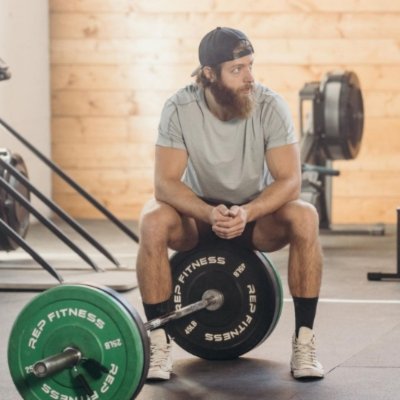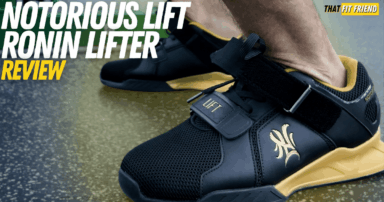Dips are awesome, and they should be a staple in most lifters’ programs or at least performed every once in a while in training blocks. They not only blow your triceps up but they can also be fantastic for passively hitting the pecs and working upper body range of motion.
I love programming dips when my goal is adding mass to my triceps. It’s tough not to see gains after doing a solid 6-8 weeks of progressively overloaded dips, and that’s why they’re a staple in my and my client’s programs.
Triceps dips are awesome for strengthening and adding mass to the triceps, pecs, and upper body. Dips can have a positive carryover for exercises like the bench press and overhead press.
How To Do Dips
Step 1: Establish a strong setup
The first step of a solid triceps dip is ensuring you’re setting up properly. To do this properly, you’ll want to make sure your hands are parallel with one another and that you’re using a width that makes sense for your body.
Most dip bars will be shaped like a V. I constantly see new lifters go too wide on the dip handle for their anatomy which then results in awkward mechanics and sub-par triceps engagement. Somewhere in the middle of a dip bar is best for most lifters.
Step 2: Jump up and lock out
After you’ve set your grip, you’ll then jump and press yourself up to a locked-out position. This is key because it will help set you up for success in your consecutive reps.
This is also a great time to let weight settle if you’re performing your dips weighted. Nothing is worse than a kettlebell or weight swinging between your legs when doing dip reps. Lock out, brace, and start your descent.
Step 3: Descend and keep the elbows consistent
As you start your descent, you’ll want to make sure your elbows are staying in a consistent position. They do NOT need to be crazy tucked to the body, and ideally, they shouldn’t be overly flared either.
There’s typically a sweet spot in the middle for most lifters regarding elbow position. If you can stack your elbows over your forearms then you’re likely in a good spot regarding your mechanics.
This will also give your triceps more leverage regarding extension at the elbow. If the elbows are flaring too much this can also lead to shoulder discomfort over time.
Step 4: Control your end range then press
Once you’ve hit an angle of about 90 degrees with the elbows you’ll press down into the dip bar and ascend while extending the arms and recruiting the triceps to do so.
Your end range position can vary and I usually coach hitting about 90 degrees at the elbow joint for most lifters but if you can go a little deeper without discomfort, then I’d do so and play with your form to see how your body responds.
At times, I’ve found a deeper range of motion can recruit a little more pec depending on how the dips are being performed. Generally, shallower dips will be a little more triceps-heavy.
Who Are Triceps Dips Best For?
From a training and coaching perspective, I think the biggest ask that I get from clients about triceps dips is, “Who are they best for and who should perform them?”
Dips are great for a wide range of clientele and lifters and below are three populations that I typically program and use dips for a variety of reasons.
1. Strength Sports Athletes Wanting to Improve Performance
The first population that I love programming triceps dips for is strength athletes. Athletes who compete in sports like CrossFit, powerlifting, strongman, and weightlifting can always use stronger upper bodies.
More specifically, dips can be great for this population for two key reasons. First, improving triceps strength is never a bad thing since all of these sports require some element of pressing strength and overhead stability.
Second, dips can be an awesome tool for strengthening the tissues of the upper body in general. When we think of dips, our minds typically just go to building the triceps, however, dips train more tissues in the body than just the muscles.
For example, dips expose our elbows and shoulders to a unique range of motion while being gradually loaded. This can be great for building more resilient connective tissues around the elbow and shoulder joints.
2. Recreational Lifters Wanting to Build Their Triceps
For the general lifter, I love dips because they’re going to train triceps extension through a different range of motion compared to your “traditional” triceps exercise. The triceps are composed of three different heads the lateral, long, and medial head.
To build these three triceps heads to their fullest extent, it’s a good idea to utilize different triceps exercises as this will give you the most “bang for your buck” regarding covering all of your bases when hitting every triceps head.
So while cable triceps pushdowns and skull crushers are great for triceps hypertrophy, I also love implementing dips in programs to give lifters additional exposure to working triceps extension through different ranges of motion.
I compare dips to exercises like pull-ups. To build a big back, it’s a good idea to train the lats through a variety of ranges of motion so doing exercises like dumbbell rows, cable rows, and pull-ups can cover a lot of our bases.
3. Lifters Wanting to Improve Their Pressing Strength
A strong press is not only the culmination of strong muscles, and I think this concept is constantly overlooked in all movement patterns. Yes, you need strong triceps to have a strong press, but you also need strong joints.
When descending, the dip puts the shoulders through a deep extension range of motion and the elbows through a deep level of flexion. In the bench press, we move through shoulder extension during the eccentric/descent and our ability to load this pattern can translate to stronger pressing.
So while the dip may not move through the exact same range of motion as the bench press, I’ve typically found that athletes with pressing goals see a nice positive carryover when programming progressively overloaded dips more regularly.
I think this is due to the dip building the triceps, pecs, and the capacity of the upper body tissues while working on elbow sequencing and control through deep ranges of motion.
Triceps Dips Muscles Worked
The triceps will primarily train the triceps but you’ll also have a nice passive carryover for other muscles like the delts, pecs, and lats. Below are some of the primary and secondary muscles used during triceps dips.
When programming dips, keep in mind that the range of motion you’re working through and your mechanics can influence “how much” you’re hitting certain muscles. For example, if you use a wider handle, you’ll likely find you feel the pecs working more.
Triceps Dips Benefits
There are countless benefits that come with performing triceps dips on a regular basis and these benefits will ebb and flow based on the context of their use.
I alluded to multiple triceps dip benefits above in my “who” section, but to simplify the benefits of performing triceps dips more regularly I wanted to share five of my favorite benefits below.
My 5 Favorite Triceps Dips Benefits
- Dips can be great for real-world carryover. In a day-to-day context, there are occasions when we’ll be moving through somewhat of a dip-like range of motion when standing up. My mind goes to housework when standing up from the floor or when working on my truck.
- Dips are awesome for building the triceps. The triceps dip can be great for training the different triceps heads and since you’re moving through deep ranges of motion while creating stability at the elbow joint your triceps will get a lot of work with reps at various intensities.
- Dips can improve your bench press and pressing strength in general. The ability to eccentrically load the shoulder through extension can be beneficial from both a strength and capacity context. Stronger shoulder and elbow joints, stronger presses.
- Dips can train the stabilizers around the shoulder joint. There’s a reason dips are tough and that’s because they require a good amount of stability on top of strength. Outside of the triceps, you’ll also be training the smaller stabilizer muscles around the shoulder joint with dips.
- Dips look cool. Let’s call it what it is — like weighted pull-ups — there’s something inherently “cool” with being able to hit heavy weighted dips or multiple bodyweight dips. The dip is one of those exercises that I think everyone should work towards and have in their toolbox. You don’t need to be a dip specialist, but it’s a good idea to have this exercise on lock.
Coaching Note: These are not the only five benefits of performing dips. However, these are the five that I keep in mind when programming and using dips for my program and my client’s programs.
Triceps Dips Mistakes
In theory, the triceps dip seems like a simple exercise. However, in practice, this is often not the case, especially for new lifters starting to learn this exercise. Below are two common dip mistakes I see in the gym.
Mistake 1: Flaring the Elbows
The first dip mistake that I see new lifters make is flaring their elbows out during reps. This typically looks like the good ole’ flared chicken wings that we see in the bench press with beginners.
When the elbows flare a ton in dips we’re not only taking away work from the triceps, but we’re also putting our shoulders into awkward positions that may lead to a little discomfort.
How to Fix This: In general, if I see a lifter flaring their elbows to complete reps I’ll assess two things. First, I’ll look at their form and see if we can fix this mistake with some simple cueing.
I’ll use cues like, “Pretend there’s a string pulling your elbows together,” or “Stack the elbows over the wrists.” Second, if the cueing doesn’t work, then it’s likely a triceps strength-related issue, and in that case, dialing back intensity would be the strategy call.
Mistake 2: Dive Bombing Reps and Working Too Deep
Another mistake that I see overzealous lifters make with dips is dive bombing reps and hitting end ranges of motion that aren’t really benefitting them in the context of their goals.
While deeper ranges of motion can typically be a good thing for strength and hypertrophy, in the context of the dip, we’ll want to consider the “active” range of motion we want to train through.
This “active” range is essentially the range of motion where the triceps can actually do their job. If we’re going too deep in reps and not controlling our reps then we may be beating up the joints more than training the muscles and connective tissues efficiently.
How to Fix This: If you’re guilty of dive bombing reps, I’d suggest programming tempos. Use a 3-second eccentric/lowering tempo, then add a 1-2 sec pause at the bottom.
This lowering or descending tempo will be beneficial for teaching you what ranges of motion are productive to be working through and the pause at the bottom can help highlight “where” you should be stopping in the context of what feels strongest and best for you.
Frequently Asked Questions (FAQ)
Q:What is triceps dips good for?
Q:Do dips really build triceps?
Q:Do tricep dips train shoulders?
Takeaway Thoughts
I love programming and using triceps dips in workout programs for a variety of reasons. They can be awesome for building all three triceps heads and for increasing the capacity of the upper body tissues.
If you’re brand new to dips, start with your body weight first and use assistance if you need it to ensure you’re tracking the elbows properly.
If you have additional questions about triceps dips or need help with your form, drop a comment below or reach out via Instagram (@jake_boly or @that_fit_friend).


















Add a Comment